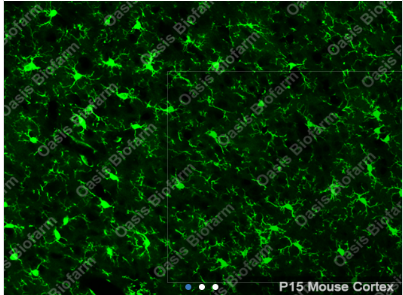
Iba1 Mouse IgG1 mAb
產(chǎn)品介紹
產(chǎn)品屬性
IBA1 Mouse IgG1 mAb
Catalog No: OB-MMS039
RRID: AB_2940798
Host Species: Mouse monoclonal antibody
Important Notice: Antigen retrieval is required for brighter signals before IHC/IF staining.
Gene Synonyms: Aif1, allograft inflammatory factor 1, IRT-1, IRT1, Iba1
Species Reactivity: Mouse, rat; Predict to work in primates
Applications: IF/IHC-Fr: 1:500~2000 IHC-P: 1:200~500 ICC: 1:500~2000
Antigen Retrieval: For an alternative approach, tissue sections could be incubated in 1x Citrate antigen retrieval solution for 30 min at 95°C and cool down to room temperature before next procedure.
Immunogen: Mouse IBA1 peptide fused to GST.
Purification: Affinity purification
General Notes: FOR RESEARCH USE ONLY
Storage Buffer: pH7.4, PBS, 50mM Tris, 50mM Glycine, ~40% Glycerol, 0.1% potassium sorbate
Storage: Shipped at 4°C. Store at -20°C for months and -80°C for years. Avoid freeze/thaw cycle.
Background: IBA1 (Ionized calcium binding adaptor molecule 1) is a 17-kDa EF-hand calcium-binding protein whose expression is restricted to microglia in the CNS and macrophages [1]. Expression of IBA1 is obvious in resting microglia and up-regulated in activated microglia following facialnerve axotomy, ischemia, and several brain diseases, thereby implicating it in the activated phenotypes of microglia [2-5]. IBA1 functions as an actin-cross-linking protein in macrophages and microglia [6,7]. Mice homozygous for a knock-out allele of Iba1 exhibit decreased spleen weight, decreased platalet cell number and decreased susceptibility to induced arthritis with normal post-natal survival [8,9].
[1] Imai Y, et al. Biochem Biophys Res Commun. 1996; DIO: 10.1006/bbrc.1996.1112
[2] Ito D, et al. Brain Res Mol Brain Res. 1998; DIO: 10.1016/S0169-328X(98)00040-0
[3] Ito D, et al. Stroke. 2001; DIO: 10.1161/01.str.32.5.1208
[4] v Eitzen U, et al. 1998; DIO: 10.1097/00005072-199803000-00006
[5] Mori I, et al. Microbiol Immunol. 2000; DIO: 10.1111/j.1348-0421.2000.tb02556.x
[6] Sasaki Y, et al. Biochem Biophys Res Commun. 2001; DIO: 10.1006/bbrc.2001.5388
[7] Ohsawa K, et al. J Neurochem. 2004; DIO: 10.1046/j.1471-4159.2003.02213.x
[8] Casimiro I, et al. Genesis. 2013; DIO: 10.1002/dvg.22424
[9] Kishikawa S, et al. Nat Commun. 2017; DIO: 10.1038/ncomms14509






